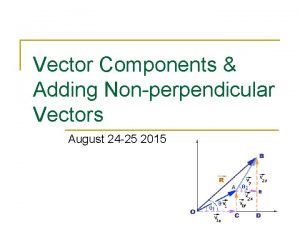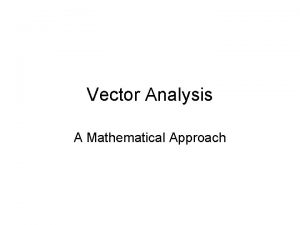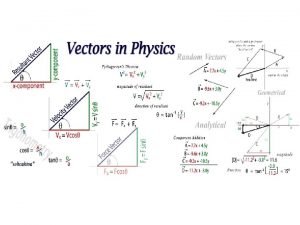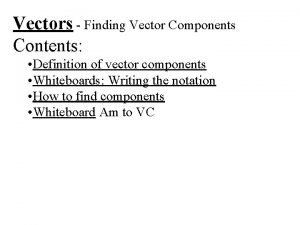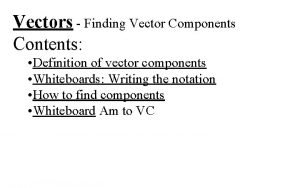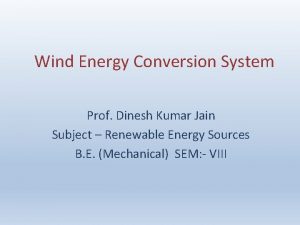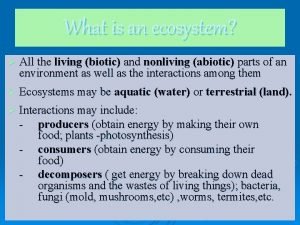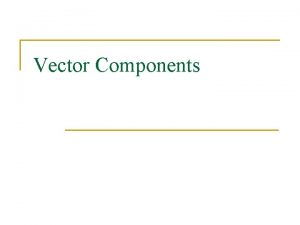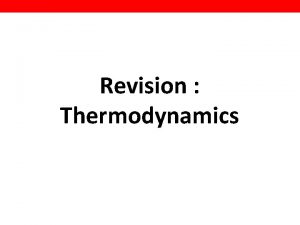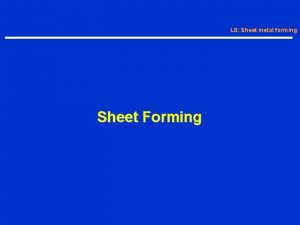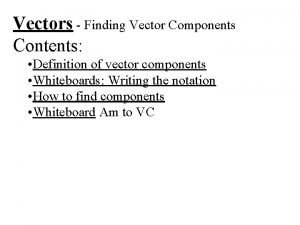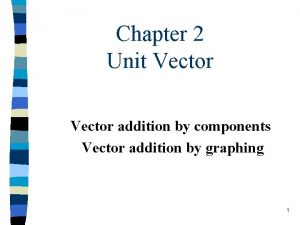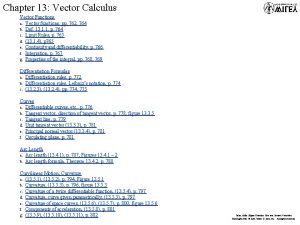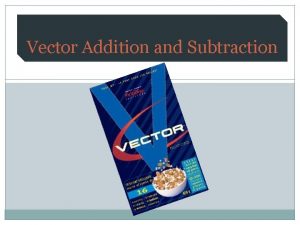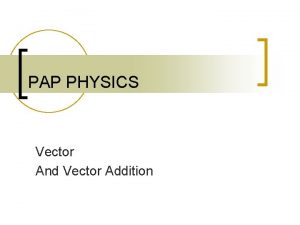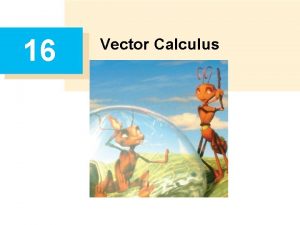Vector Components Day 1 Vector Sheet C Day































- Slides: 31

Vector Components Day #1 Vector Sheet C Day #2 Vector Sheet D & E {skip 3 dimensional problems}

HW: Vector Sheet C, #1 – 9. Vector Sheet D, #1 – 6, Vector Sheet E, #4 – 7.

Physics Unit 2: Vectors Vector Components Review Problem: Vectors: Find the total displacement of. . . Vector A: 116 km 34. 0° SE Vector B: 182 km 16. 5° ES N W a E 34. 0° A= R 116 km 140. 5° total 34. 0° 90. 0° = nt k 182 ta B= es ul 16. 5° R m S

Solve for the length of the resultant with the law of cosines. Next use law of sines to solve for a. Finally add 34. 0 o to a for the direction.

What math processes would be required if we added another vector to these two vectors? And again? At some point, it will be much easier to break vectors into parts, called components, and then analyze it that way.

Addition of Vector using the Component Method: Adding vectors is the same as adding the components.

I. Component __________ Method of Vector Addition: This is another way to represent a vector: to use coordinates rather than length and angle. Method Give the position of the x and y coordinates of the tip of the vector, n. b. the angular brackets are used to show the coordinates of the tip of the vector, rather than just an ordered pair of numbers.

components The __________ of a vector are the projection of the vector onto the coordinate axes. The lengths of the components are the same as the (x, y) coordinates of the tip of the vector. For the vector shown at right, the length of the projection of the vector on the horizontal axis. the length of the projection of the vector on the vertical axis. the coordinates of the tip of the vector.

vectors The components of a vector can also be treated at _______ , and the vector can be thought of as the sum of its components. the coordinates of the tip of the vector.

Example #1: For the vectors shown at right, which vector is drawn to correctly match the components? NO YES NO NO YES

II. Converting components into magnitude and direction and vice versa: SOH CAH TOA! Very Important Skills on this slide!

Example #2: A force of 155 Newtons acts at an angle of 37. 0° above the horizontal. What are the horizontal and vertical components of the force. F q SOH CAH TOA! Fx Fy

Example #3: Tiger Woods hits a golf ball 165 km/h 40. 0° above the horizontal. Find the component velocities of the ball vertical 5 16 /h m k Vy 40. 0 o horizontal Vx

Example #4: An airplane is flying 525 mi/h 24. 5° E of N. After 2. 50 h, what are the Northern and Eastern displacements? 5 m 52 24. 5° i/h North or +y East or +x

Example #5: Show the value of the components of vectors that act horizontally or vertically. Be careful about the + or – sign! +y A +x +y B +x

+y C +x +y +x D

IV. Addition of Vector using the Component Method: Adding vectors is the same as adding the components.

Example #6: What is the sum of the following two displacements? Omit: This is review

Example #7: Find the displacement: 122 km 37. 0° NE, 175 km 17. 5° WS Draw the two vectors, with each starting at the origin. N SOH CAH TOA! 1 A= W k 22 m 37. 0 o 17. 5 o B=17 5 km E S

Calculate the components of the vectors: X Components Y Components We still need to find magnitude and direction for this vector.

N W E S

Example #8: To be on schedule a pilot needs to arrive at airport in 5. 00 hours. The airport is located 1500 km 40. 0° NW of her present location. If the wind averages 70. 0 km/h from the southwest, where should she aim and how fast should she fly? SOH CAH TOA! unknown Wind is from the southwest, so towards N o the northeast. The angle is 45. 0. R= wind = 70. 0 km/h De 45. 0° P=p ilot sh sir ed ve loc ould f 40. 0° ly ity =3 00 km /h W E S

Calculate the components of the vectors: X Components Y Components Sadly, we are not done yet… We still need to find magnitude and direction for this vector.

N W E S

Finally the big moment. . . adding vectors using the component method! Example #9: Find the total force: (1) A = 18. 0 N 33. 0° NE (2) B = 16. 0 N 28. 0° NW (3) C = 7. 00 N 12. 0° WS (a) First make a diagram N or +y B A 28. 0° 33. 0° W 12. 0° E or +x C S

(b) now find all the x and y components and add them together separately: (1) A = 18. 0 N 33. 0° NE (2) B = 16. 0 N 28. 0° NW (3) C = 7. 00 N 12. 0° WS

The resultant (sum) vector is the sum of the vectors. The components of the sum vector (R) equals the sum of the corresponding components. (c) Now find the magnitude of the resultant : (d) finally find the direction Ry R q Rx




Homework. Use a straightedge and sketch a vector. . Calculate the value of Ax and Ay. SOH CAH TOA!
 Day 1 day 2 day 3 day 4
Day 1 day 2 day 3 day 4 Day 1 day 2 day 817
Day 1 day 2 day 817 Meaning of stock verifier
Meaning of stock verifier How to add non perpendicular vectors
How to add non perpendicular vectors Components of a vector calculator
Components of a vector calculator Magnitude of a vector
Magnitude of a vector Vector components definition
Vector components definition Vector components definition
Vector components definition Vector trigonometry
Vector trigonometry Find a unit vector in the direction of the given vector.
Find a unit vector in the direction of the given vector. Ay cosa
Ay cosa Why is vector resolution the opposite of vector addition
Why is vector resolution the opposite of vector addition Given: the 420 n force along the cable ac.
Given: the 420 n force along the cable ac. Insulin chart nursing
Insulin chart nursing Family sis schoolmax
Family sis schoolmax Haiku and
Haiku and Day to day maintenance
Day to day maintenance Physical science chapter 6 review answers
Physical science chapter 6 review answers I don't know about tomorrow i just live from day to day
I don't know about tomorrow i just live from day to day Romeo and juliet summary
Romeo and juliet summary Growing day by day
Growing day by day Define seed dormancy
Define seed dormancy Seed germination conclusion
Seed germination conclusion Geotropism
Geotropism I live for jesus day after day
I live for jesus day after day Casting crowns glorious day (living he loved me)
Casting crowns glorious day (living he loved me) Day one day one noodle ss2
Day one day one noodle ss2 Tactique futsal
Tactique futsal Wood frame components
Wood frame components What is wind energy conversion system
What is wind energy conversion system Whmis hazard categories 1-4
Whmis hazard categories 1-4 Biotic components of an ecosystem
Biotic components of an ecosystem



